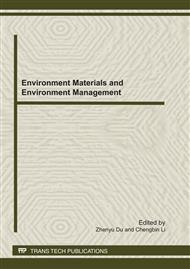[1]
Lovei GL (1997) Biodiversity–Global change through invasion. Nature 388: 627–628.
Google Scholar
[2]
Fang W (2000) Biological invasion and global change. In: Fang JY (eds) Global Ecology: Climatic Change and Ecological Response. Higher Education Press, Beijing.
Google Scholar
[3]
McNeely JA, Mooney HA, Neville LE, Schei P, Waage JK (2001) A Global Strategy on Invasive Alien Species. IUCN, Gland and Cambridge.
Google Scholar
[4]
Guo QF (2002) Perspectives on trans-Pacific biological invasions. Acta Phytoecol Sin 26: 724–730.
Google Scholar
[5]
Xu HG, Ding H, Li MY, Qiang S, Guo JY, Han ZM et al (2006) The distribution and economic losses of alien species invasion to China. Biol Invasions 8: 1495–1500.
DOI: 10.1007/s10530-005-5841-2
Google Scholar
[6]
Jenkins PT, Mooney HA (2006) The United States, China, and invasive species: present status and future prospects. Biol Invasions 8: 1589–1593.
DOI: 10.1007/s10530-005-5852-z
Google Scholar
[7]
Pimentel D, Lach L, Zuniga R, Morrison D (2000) Environmental and economic costs of nonindigenous species in the United States. BioScience 50: 53–65.
DOI: 10.1641/0006-3568(2000)050[0053:eaecon]2.3.co;2
Google Scholar
[8]
PyŠek P, Richardson DM, Rejmanek M, Webster GL, Williamson M and Kirschnerl J (2004) Alien plants in checklists and floras: towards better communication between taxonomists and ecologists. Taxon 53 (1): 131–143.
DOI: 10.2307/4135498
Google Scholar
[9]
Colautti RI, Richardson DM (2009) Subjectivity and flexibility in invasion terminology: too much of a good thing? Biol Invasions 11: 1225–1229.
DOI: 10.1007/s10530-008-9333-z
Google Scholar
[10]
Liu J, Liang SC, Liu FH, Wang RQ, Dong M (2005) Invasive alien plant species in China: regional distribution patterns. Divers and Distrib 11: 341–347.
DOI: 10.1111/j.1366-9516.2005.00162.x
Google Scholar
[11]
Liu J, Dong M, Miao SL, Li ZY, Song MH, Wang RQ (2006) Invasive alien plants in China: role of clonality and geographical origin. Biol Invasions 8: 1461–1470.
DOI: 10.1007/s10530-005-5838-x
Google Scholar
[12]
Weber E, Sun SG, Li B (2008). Invasive alien plants in China: diversity and ecological insights. Biol Invasions 10: 1411–1429.
DOI: 10.1007/s10530-008-9216-3
Google Scholar
[13]
Weber E, Li B (2008) Plant invasions in China: what is to be expected in the wake of economic development? BioScience 58: 437–444.
DOI: 10.1641/b580511
Google Scholar
[14]
Huang QQ, Wu JM, Bai YY, Zhou L, Wang GX (2009) Identifying the most noxious invasive plants in China: role of geographical origin, life form and means of introduction. Biodivers Conserv 18: 305–316.
DOI: 10.1007/s10531-008-9485-2
Google Scholar
[15]
Feng JM, Zhu YY (2010) Alien invasive plants in China: risk assessment and spatial patterns. Biodivers Conserv DOI 10. 1007/s10531-010-9909-7 (published online).
DOI: 10.1007/s10531-010-9909-7
Google Scholar
[16]
Wang S, Xie Y, Mittermeier RA (1997) China. In: Mittermeier RA, Gil PR, Mittermeier CG (eds) Megadiversity-earth's biologically wealthiest nations. Cemex, Quebecor Printing Inc., Montreal.
Google Scholar
[17]
Xie Y, Li ZY, Gregg WP, Li DM (2001) Invasive species in China–an overview. Biodivers Conserv 10: 1317–1341.
Google Scholar
[18]
Ding, JQ and Wang, R (1998) Invasive alien species and their impact on biodiversity in China. In: the Compilation Group of China's Biodiversity (eds) China's biodiversity: a country study, p.58–63. China Environmental Science Press, Beijing.
Google Scholar
[19]
Li B, Xu BS, Chen JK (2001) Perspectives on the general trends of plant invasion with special reference to alien flora of Shanghai. Biodivers Sci 9: 446–457.
Google Scholar
[20]
Li ZY, Xie Y (2002) Invasive Alien Species in China. China Forestry Publishing House, Beijing.
Google Scholar
[21]
Wan FH, Guo JY, Wang DH (2002) Alien invasive species in China: their damages and management strategies. Biodivers Sci 10: 119–125.
Google Scholar
[22]
Weber E, Gut D (2004) Assessing the risk of potentially invasive plant species in central Europe. J Nat Conserv 12: 171–179.
DOI: 10.1016/j.jnc.2004.04.002
Google Scholar
[23]
Xu HG, Qiang S (2004) Inventory of invasive alien species in China. China Environmental Science Publication, Beijing.
Google Scholar
[24]
Xu HG, Qiang S, Han ZM, Guo JY, Huang ZG, Sun HY, He SP, Ding H, Wu HR, Wan FH (2006) The status and causes of alien species invasion in China. Biodivers Conserv 15: 2893–2904.
DOI: 10.1007/s10531-005-2575-5
Google Scholar
[25]
Ou Jian, Lu CY , O'toole DK (2008) A risk assessment system for alien plant bio-invasion in Xiamen, China. J Environ Sci 20: 989–997.
DOI: 10.1016/s1001-0742(08)62198-1
Google Scholar
[26]
Xiang YC, Peng SL, Zhou HC and Cai X (2002) The impacts of non-native species on biodiversity and its control. Guihaia: 22(5): 425–432.
Google Scholar
[27]
Lin W, Zhou GF, Cheng XY, Xu RM (2007) Fast Economic Development Accelerates Biological Invasions in China. PLoS one 11: 1–6.
DOI: 10.1371/journal.pone.0001208
Google Scholar
[28]
Wu SH, Sun HT, Teng YC, Rejmánek M, Chaw SM, Yang TYA, Hsieh CF (2010) Patterns of plant invasions in China: Taxonomic, biogeographic, climatic approaches and anthropogenic effects, Biol Invasions, 12: 2179–2206.
DOI: 10.1007/s10530-009-9620-3
Google Scholar
[29]
Ding J, Mack RN, Lu P, Ren M, Huang H (2008) China's booming economy is sparking and accelerating biological invasions. BioScience 58: 317–324.
DOI: 10.1641/b580407
Google Scholar
[30]
Li Y H (1998) Weeds Flora of China. Chinese Agricultural Press, Beijing.
Google Scholar


